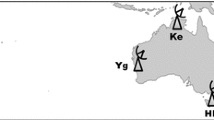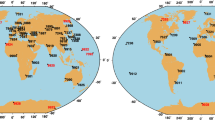Abstract
The AuScope geodetic Very Long Baseline Interferometry array consists of three new 12-m radio telescopes and a correlation facility in Australia. The telescopes at Hobart (Tasmania), Katherine (Northern Territory) and Yarragadee (Western Australia) are co-located with other space geodetic techniques including Global Navigation Satellite Systems (GNSS) and gravity infrastructure, and in the case of Yarragadee, satellite laser ranging (SLR) and Doppler Orbitography and Radiopositioning Integrated by Satellite (DORIS) facilities. The correlation facility is based in Perth (Western Australia). This new facility will make significant contributions to improving the densification of the International Celestial Reference Frame in the Southern Hemisphere, and subsequently enhance the International Terrestrial Reference Frame through the ability to detect and mitigate systematic error. This, combined with the simultaneous densification of the GNSS network across Australia, will enable the improved measurement of intraplate deformation across the Australian tectonic plate. In this paper, we present a description of this new infrastructure and present some initial results, including telescope performance measurements and positions of the telescopes in the International Terrestrial Reference Frame. We show that this array is already capable of achieving centimetre precision over typical long-baselines and that network and reference source systematic effects must be further improved to reach the ambitious goals of VLBI2010.








Similar content being viewed by others
References
Altamimi Z, Collilieux X, Legrand J, Garayt B, Boucher C (2007) ITRF2005: A new release of the international terrestrial reference frame based on time series of station positions and Earth Orientation Parameters. J.Geophys Res 112:B09401
Altamimi Z, Collilieux X, Métivier L (2011) ITRF2008: an improved solution of the international terrestrial reference frame. J Geodesy 85:457–473
AuScope (2012) AuScope: An organisation for a national earth science infrastructure program. http://www.auscope.org.au
Böhm J, Werl B, Schuh H (2006) Troposphere mapping fucntions for GPS and very long baseline interferometry from European centre for medium-range Weather Forecasts operational analysis data. J Geophys Res 111:B02406
Charlot P (1990) Radio-source structure in astrometric and geodetic very long baseline interferometry. AJ 99:1309–1326
Deller AT, Tingay SJ, Bailes M, West C (2007) DiFX: A software correlator for very long baseline interferometry using multiprocessor computing environments. PASP 119:318–336
Deller AT, Brisken WF, Phillips CJ, Morgan J, Alef W, Cappallo R, Middelberg E, Romney J, Rottmann H, Tingay SJ, Wayth R (2011) DiFX-2: a more flexible, efficient, robust, and powerful software correlator. PASP 123:275–287
Eubanks TM (1991) A Consensus Model For Relativistic Effects In Geodetic VLBI. In: Eubanks TM (ed) Proceedings of the US Naval Observatory Workshop on relativistic models for use in Space Geodesy. U. S. Naval Observatory, pp 60–82.
Fey AL, Charlot P (1997) VLBA observations of radio reference frame sources. II. astrometric suitability based on observed structure. ApJS 111:95
Fey AL, Gordon D, Jacobs CS (2009) The Second Realization of the International Celestial Reference Frame by Very Long Baseline Interferometry. IERS Tech Note 35
Gatti MS (2004) The Deep Space Network Large Array. Technical Report 42–157. Jet Propulsion Laboratory, California
Gulyaev S, Natusch T (2010) New Zealand 12 m VLBI Station. In: Behrend D, Baver KD (eds) International VLBI service for geodesy and astrometry 2009 AnnualReport, number NASA/TP 2010–215860. pp 138–141
Herring TA, Mathews PM, Buffett B (2002) Modeling of nutation-precession: very long baseline interferometry results. J Geophys Res 107:2069
Imbriale WA (2005) Radio frequency optics design of the 12-meter antenna for the array-based deep space network. The Interplanetary Network Progress, Report, pp 42–160
Kettenis M, van Langevelde HJ, Reynolds C, Cotton B (2006) ParselTongue: AIPS Talking Python. In: Gabriel C, Arviset C, Ponz D, Enrique S (eds) Astronomical data analysis software and systems XV, volume 351 of Astronomical Society of the Pacific Conference Series. p 497
Kopeikin SM (1990) Theory of relativity in observational radio astronomy. Soviet Ast 34:5
Ma C, Arias EF, Bianco G, Boboltz DA, Bolotin SL, Charlot P, Engelhardt G, Fey AL, Gaume RA, Gontier A-M, Heinkelmann R, Jacobs CS, Kurdubov S, Lambert SB, Malkin ZM, Nothnagel A, Petrov L, Skurikhina E, Sokolova JR, Souchay J, Sovers OJ, Tesmer V, Titov OA, Wang G, Zharov VE, Barache C, Boeckmann S, Collioud A, Gipson JM, Gordon D, Lytvyn SO, MacMillan DS, Ojha R (2009) The Second Realization of the international celestial reference frame by very long baseline interferometry. IERS Tech Note 35:1
MONICA (2011) open-monica. http://code.google.com/p/open-monica/
NCRIS (2006) National collaborative research infrastructure strategy (NCRIS). http://www.innovation.gov.au/Science/ResearchInfrastructure/Pages/NCRIS.aspx
Neidhardt A, Ettl M, Plötz C, Mühlbauer M, Hase H, Sobarzo Guzmán S, Herrera Ruztort C, Alef W, Rottmann H, Himwich E (2010) Interacting with radio telescopes in real-time during VLBI sessions using e-control. In: Proceedings of the 10th European VLBI network symposium and EVN users meeting: VLBI and the new generation of radio arrays. September 20–24, 2010. Manchester, UK
Niell A, Whitney A, Petrachenko W, Schlüter W, Vandenberg N, Hase H, Koyama Y, Ma C, Schuh H, Tuccari G (2007) VLBI2010: A Vision for Future Geodetic VLBI. In: F. Sanso (ed) Dynamic Planet —Monitoring and understanding a dynamic planet with geodetic and oceanographic tools, vol 130, p 757
Nothnagel A, Vennebusch M, Campbell J. (2002) On correlations between parameters in geodetic VLBI data analysis. In: Vandenberg N, Baver KD (eds) IVS 2002 general meeting proceedings, p 260
Ott M, Witzel A, Quirrenbach A, Krichbaum TP, Standke KJ, Schalinski CJ, Hummel CA (1994) An updated list of radio flux density calibrators. A &A 284:331–339
Petit G, Luzum B (2010) IERS Conventions (2010). IERS Tech Note 36:179
Petrachenko WT, Schuh H, Niell AE, Behrend D, Corey BE (2010) VLBI2010: Next Generation VLBI System for Geodesy and Astrometry. AGU Fall Meeting Abstracts, p B6
Ruddick R, Woods A (2012) The 2009 Mount Pleasant (Hobart) Observational Local Tie Survey. Geoscience Australia Record (in preparation)
Schuh H, Behrend D (2012) VLBI: A fascinating technique for geodesy and astrometry. J Geodyn 61:68–80
Shabala SS, Titov O, Lovell J, McCallum J, Blanchard J, Watson C, Dickey J (2012) Quasar structure effects on the VLBI reference frame: the case of 1144\(-\)379. IVS 2012 General Meeting Proceedings (submitted)
Shabala SS, Memin A, McCallum J (2013) Systematic Biases in Geodetic VLBI Analysis. Publications of the Astronomical Society of Australia (submitted)
Soffel MH, Wu X, Xu C, Mueller J (1991) Consistent relativistic VLBI theory with picosecond accuracy. AJ 101:2306–2310
Tingay SJ, Alef W, Graham D, Deller AT (2009) Geodetic VLBI correlation in software. J Geod 83(11):1061–1069
Titov O (2007) Effect of the selection of reference radio sources on geodetic estimates from VLBI observations. J Geod 81:455–468
Titov O (2009) A new estimator for VLBI baseline length repeatability. J Geod 83(11):1041–1049
Titov O, Tesmer J, Boehm J (2004) OCCAM v6.0 software for VLBI data analysis. In: Vandenberg N, Baver K (eds) Proceedings of the 2004 IVS 3rd general meeting. p 267
Tornatore V, Charlot P (2007) The impact of radio source structure on European geodetic VLBI measurements. J Geod 81:469
Walker RC (1995) What the VLBA Can Do for You: Capabilities, Sensitivity, Resolution, and Image Quality. In: Zensus JA, Diamond PJ, Napier PJ (eds) Very long baseline interferometry and the VLBA, volume 82 of, Astronomical Society of the Pacific Conference Series. pp 133–157
Acknowledgments
This study made use of data collected through the AuScope initiative. AuScope Ltd is funded under the National Collaborative Research Infrastructure Strategy (NCRIS), an Australian Commonwealth Government Programme. JM ad SS were supported under the Australian Research Council’s Super Science funding scheme (projects FS110200045 and FS100100037). We wish to thank our reviewers for a comprehensive and constructive list of comments. Last, we wish to thank the International VLBI Service for Geodesy and Astrometry (IVS) for access to VLBI data products used in this paper and for advice and support during the conception, design, commissioning and operation of the AuScope VLBI Array.
Author information
Authors and Affiliations
Corresponding author
Electronic supplementary material
Below is the link to the electronic supplementary material.
Rights and permissions
About this article
Cite this article
Lovell, J.E.J., McCallum, J.N., Reid, P.B. et al. The AuScope geodetic VLBI array. J Geod 87, 527–538 (2013). https://doi.org/10.1007/s00190-013-0626-3
Received:
Accepted:
Published:
Issue Date:
DOI: https://doi.org/10.1007/s00190-013-0626-3




